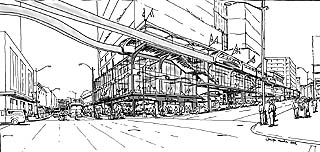|
Subscribe / Renew |
|
|
Contact Us |
|
| ► Subscribe to our Free Weekly Newsletter | |
| home | Welcome, sign in or click here to subscribe. | login |
Construction
| |
 |
September 5, 2002
A pitch for the monorail
Stoneham/Blakley

The 14-mile Green Line would include 19 stations along its run from West Seattle to Ballard. This rendering of the monorail stop at Second and Pike was proposed by Samis Land Co., which would build the station into a 24-story mixed-use project. |
Seattle voters will have a chance to decide on the monorail plan on Nov. 5.
Here are some highlights of the plan:
Why a monorail?
- It operates above the roadways, so it’s immune to traffic problems.
- Because of that, you can count on getting where you’re going — on time — every time.
- It’s less expensive to build — uses public right of way.
- It will be up and running quickly, with its first phase operational by 2007 and the complete first phase by 2009.
What will it look like? In general, it will be similar to the Seattle Center monorail, which was built for the 1962 World’s Fair. Like all monorails, it will consist of four major components: cars, columns, guideways, and stations.
The cars will be operated by computers (like the trains at Sea-Tac Airport), which are more efficient at maintaining a regular schedule and at providing smoother starts and stops. Computer operation also gives greater flexibility in scheduling monorail trains. However, there will be monorail attendants riding the trains and monitoring the stations for safety and to provide customer service.
Monorails have historically been extremely durable and reliable — their quiet (monorails are quieter than city buses) rubber tires experience very little wear and normally go over 100,000 miles before they have to be replaced. The new monorail’s cars are designed to run for 30 years or 3 million miles, whichever comes first.
Where will the monorail run? The first phase, the Green Line, is a 14-mile route running from Ballard, through Interbay to the Seattle Center and on to the downtown retail and business core. From West Seattle, the monorail will cross over the West Seattle Bridge through Sodo and near the International District with a major intermodal stop at the King Street Station connecting the monorail with light rail, commuter rail and Amtrak. Throughout the route, there will be opportunities at every station for bus transfers.
This route was chosen based on employment, population densities, future growth, areas served by existing transit as well as extensive citizen input.
There will be 19 stations along the route serving such popular destinations as the Seattle Center, Key Arena, Pike Place Market, Pioneer Square, King Street Station, the Chinatown/International District, as well as Seahawks Stadium and Safeco Field.
Future expansions can extend the Green Line: add two north-south lines and two east-west lines to create a 58-mile, five-line, citywide system.
How much will it cost and who’s going to pay for it? The estimated $1.29 billion construction of the Green Line (which includes contingency funds of $210 million) plus an additional $439 million in reserves will be funded by a 1.4 percent annual motor vehicle excise tax in the city of Seattle.
To put things in perspective, the excise tax on a $10,000 vehicle would be $140 in the first year (the tax will decline as the vehicle depreciates) but with a federal tax deduction, that could be reduced to $102.
The income from fares of the estimated 20 million passengers per year, combined with advertising revenue, should pay the operations and maintenance costs within a few years after opening, which means an ongoing public subsidy would not be necessary.
Stoneham/Blakley is an advertising agency hired by the Elevated Transportation Co.
Other Stories:
- Puget Sound ports get that sinking feeling
- Tough choices ahead at the ballot box
- Engineers support Referendum 51
- Stuck in traffic? We’ve got a plan


